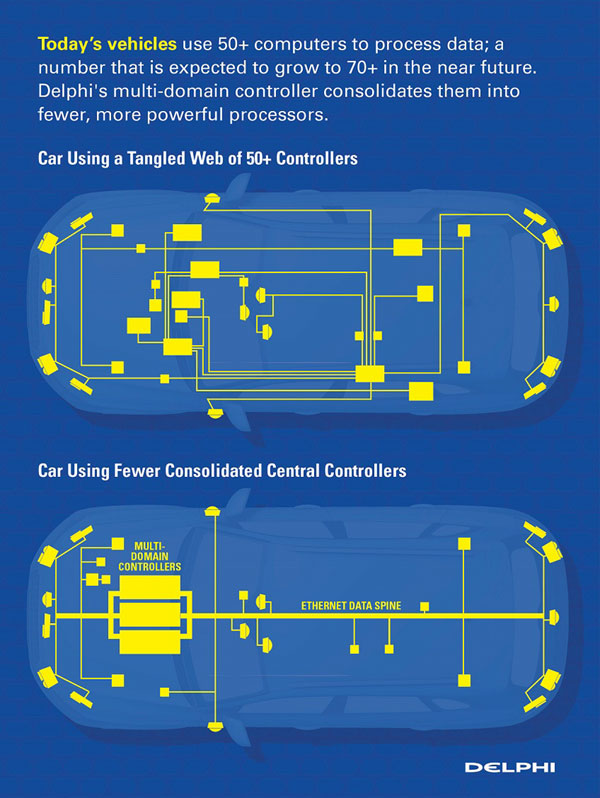
A key component in the future of motoring, Delphi looks at the introduction of multi-domain controllers to handle more data than ever before.
With the fixation on automated cars, advanced propulsion systems and renewable energy, we almost missed it. Missed what, you ask? The keys to the future of the automobile. Data.
Or, more accurately, the ability to move and share data at very high speeds within and among vehicles. How much and how fast? The answers will determine whether or not the industry can solve huge societal problems — like accidents, pollution and congestion.
The average car today is basically a giant computer. It has more than 50 electronic control units and 100 million lines of code. Delphi ships more than 20 billion lines of code daily. As complex as that sounds, in some ways the “nervous system” of today’s car is antiquated.
“We are reaching a limit to what the car can do,” said Jeff Owens, Delphi’s chief technology officer. “The auto industry must find a new way to move information much, much more quickly.”
For Delphi, the answer lies in a new vehicle architecture, or “nervous system,” and multi-domain controllers, or “uber brains,” to manage a number of functions at once.
The brains of this operation: Multi-domain controllers
Increased active safety and connectivity content in the car will cause the number of computers on the average car to swell from 50 to 70 electronic control units within the next five years. The introduction of multi-domain controllers — a powerful control center that brings multiple electronic sub-systems together — could help lessen that burden by increasing computing power in smaller and fewer, but more powerful controllers.
These “uber brains,” or multi-domain controllers, can process massive amounts of data and manage several functions at once; unlike current domains that can only control one function at a time. Although the number of computers in the car will continue to grow as the demand for content in the car increases, we will be able to manage it with fewer computers.
”We are creating a vehicle architecture that will have enough processing power and flexibility to add features in the future that don’t exist today and add those features to older model cars,” said Owens.
Vehicle architecture of the future will have enough bandwidth for car companies to imagine features years before consumer offerings and they will be able to replace and upgrade systems with over-the-air upgrades. It’s easy to talk about an upgrade, but it’s not easy if there isn’t any room for it.
With an open architecture automakers are able to choose unique, tailored-made functionalities that can be integrated during vehicle development or well after a vehicle is sold for a scalable and flexible systems solution.
“This is brand new. A game-changer for the industry and Delphi is at the forefront of it,” Owens said. “The first of these multi-domain controllers will be used in Audi vehicles starting in 2016.”
The movers and shakers: Ethernet, connectors and data lines
If multi-domain controllers act as the brains of the car, how does the information it has stored get fed to the right function at the right time? Multi-domain controllers will leverage a multiplexed electrical system, which can transfer data at lightning speed through efficient and lightweight connection technology so decisions can be made in a blink of an eye; before a human ever could.
Inside the car today, most information is being moved at less than one megabit per second, depending on the function, using a common language that was created in the 1980s. Going forward, the speed will need increasing by 1,000 times and decisions will need to be made by a well-connected system of controllers. “If you think of automotive systems in terms of traffic flow, the architecture of our cars today is beginning to look like a Shanghai traffic jam,” Owens said. “It’s rush hour and no one is moving. With all the benefits coming down the pike — from active safety, more efficient engines and controls and more connectivity — we are going to need the equivalent of a new Super Highway where cars can move at 200 miles per hour and not worry about traffic.”

The information being sent throughout the car — like braking, acceleration, temperature, pressure, voltage, steering angle — is critical. One hiccup could lead to a serious problem.
Data lines and connectors will act as the Super Highway to handle the transfer of data at lightning speed. Ethernet will dominate because of its bandwidth capability, common language and protocols — the ability to control passing information and avoid simultaneous transmission by two or more systems.
“This new vehicle architecture is the industry’s best kept secret,” said Owens. “It’s the unsung hero that no one is talking about. “The future of driving, especially automated driving, hinges on whether the auto industry can find a new way to move information much, much more quickly.”
The modern vehicle’s exchange of high-speed data is driving fundamental shifts in vehicle architecture for the first time in years. Delphi is uniquely positioned to support these shifts with industry-first technology, like its multi-domain controller, and electrical architectures that support moving data faster than ever.
“Very few companies have experience as deep as Delphi in electrical architecture, software and systems integration at automotive grade quality,” said Owens.










